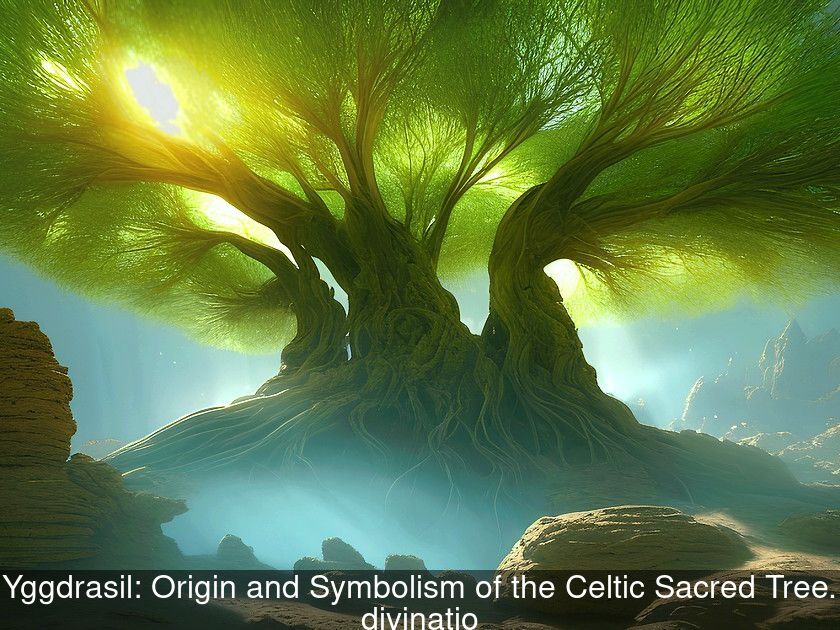Yggdrasil: Origin And Symbolism Of The Celtic Sacred Tree.
In Norse cosmology, the entire universe and its various dimensions are represented in the form of a tree. This gigantic ash tree, which stretches across the nine worlds or realms of Norse mythology, is called Yggdrasil. We invite you to discover the origin of this sacred Celtic tree and the multiple symbols associated with it.
A symbolic representation of the universe.
The Celtic sacred tree Yggdrasil, sometimes referred to as the World Tree, is one of the most important symbols in Norse cosmology. This tree, often described as an ash tree, is a representation of the entire universe and its different dimensions.
Its name literally means "Ygg's horse," with Ygg (the Terrible) being a way to refer to the god Odin in Norse myths. Odin, the god of wisdom, is often depicted sitting beneath this tree.
In Norse mythology, this sacred ash tree serves as the axis of the universe. It is said to have taken root in the body of Ymir (the first living creature and the source of Earth's creation) and rose up to the sky after the creation of Midgard (our world).
One of the oldest Norse myths.
The first mention of the sacred tree Yggdrasil dates back to the Poetic Edda, a collection of poems in Old Norse that tells the stories of Norse mythology. These stories are gathered in a 13th century Icelandic manuscript, the Codex Regius, which is the most important source of knowledge about Scandinavian mythology.
It should be noted, however, that the archetype of a cosmic tree connecting different parts of the Universe is common to many civilizations. This tree connecting the celestial, earthly, and underworld can be found among various Indo-European peoples as well as among pre-Columbian peoples and shamanistic peoples of Siberia.
The World Tree of Norse mythology has survived through the centuries and continues to appear in popular culture. It notably inspired fantasy author Christopher Paolini in the creation of the character Menoa Tree, a spiritual entity in Ellesmera in the literary saga The Inheritance (Eragon).
The nine worlds of Norse mythology
If we believe the texts, the sacred tree Yggdrasil is a gigantic ash tree that extends throughout the nine worlds of Norse mythology. The nine worlds or realms are interconnected by the roots, trunk, and branches of this tree.
In Norse cosmology, the nine worlds are interconnected and interdependent, representing different aspects of the universe. The world tree has three roots that connect the world of giants, the world of humans, and the world of the dead.
The 9 worlds of Norse mythology are:
• Ásgard or Asaheim, the realm of the Aesir
• Vanaheim, the realm of the Vanir
• Álfheim, the realm of the light elves or ljósálfar
• Midgard or Mannheim, the realm of the middle (the world of humans)
• Jötunheim, the realm of the giants
• Svartalfheim, the realm of the dark elves or dökkalfar and sometimes the dwarves
• Niflheim or Nibelheim, the realm of mists and the Nibelungs
• Muspellheim, the realm of fire
• Helheim, the realm of the dead.
A tree loaded with symbolism
The Celtic sacred tree Yggdrasil is associated with life and death. According to Norse mythology, a sacred water source guarded by three nymphs is located at the foot of the tree. As a source of life and regeneration, it allows the resurrection of the gods.
Norse myths also tell that the branches of the sacred tree shelter many animals and mythical creatures. An eagle perches on the top of the tree, a dragon lives in its roots, and a goat feeds on its leaves.
Four deer Dain, Duneyr, Durathror, and Dvalin run in its branches and also feed on its foliage. A fifth deer, Eikthyrnir, grazes on the twigs, and from its horns flows the water that falls into the cauldron Hvergelmir.
Finally, the world tree is considered a symbol of wisdom and knowledge. Odin, who is among other functions the god of knowledge, is often depicted meditating under this tree.


